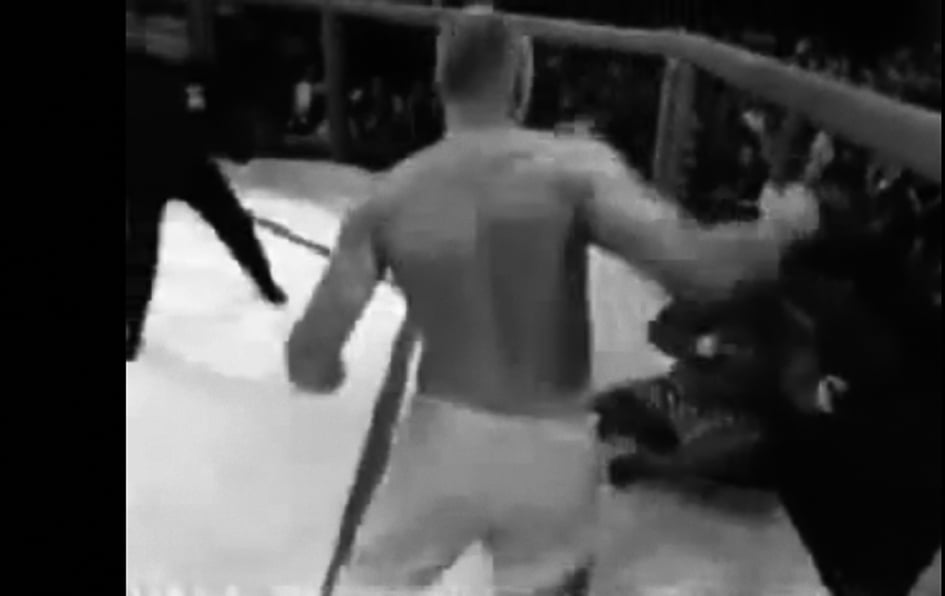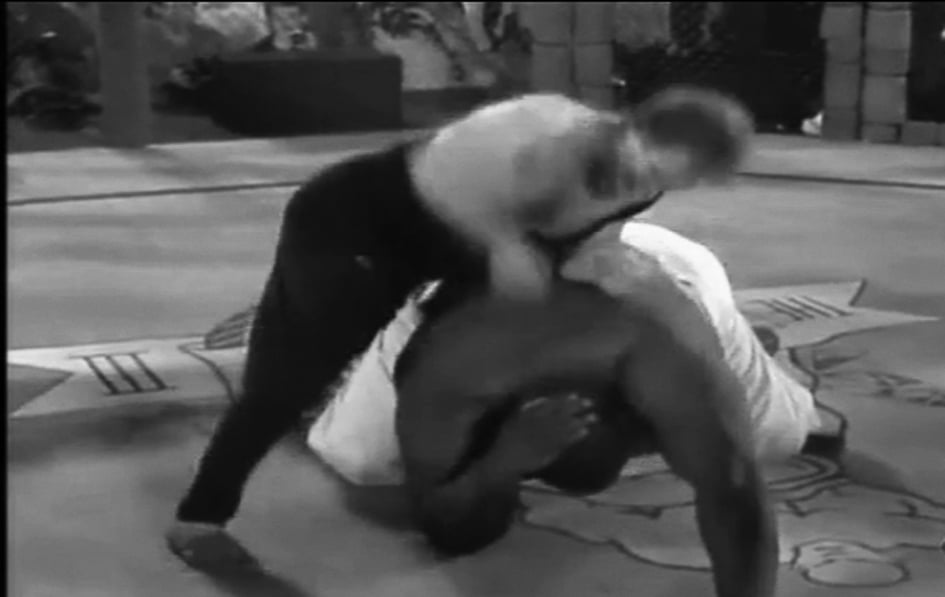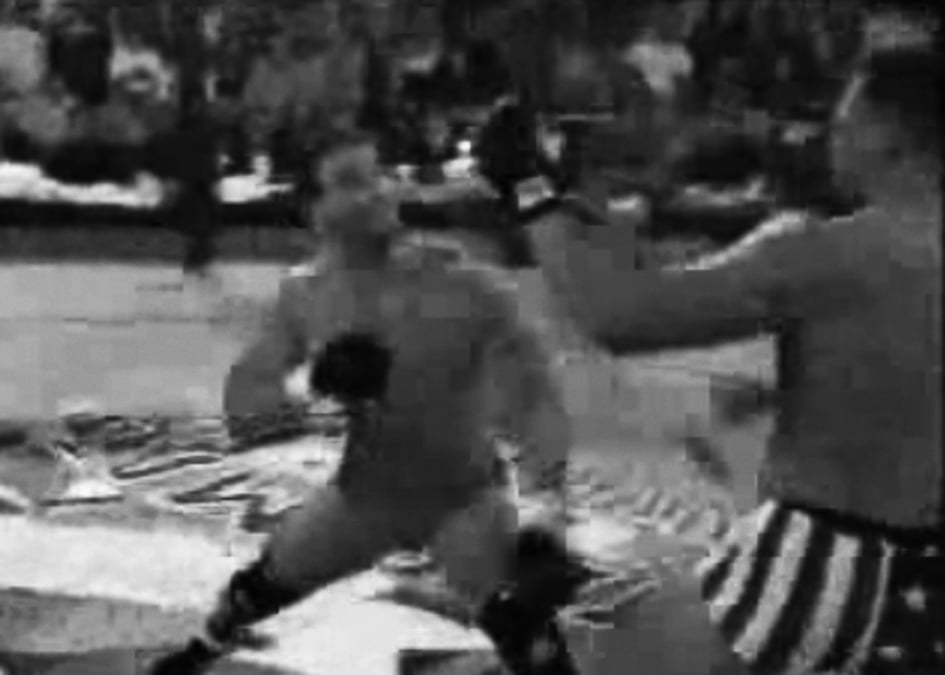
Issue 102
June 2013
Gloves in MMA are used to protect hands and not heads. And, for the benefit of those of you watching at home, they’re definitely here to stay – despite some interesting information...
Things were very different back in the early days of mixed martial arts. As well as headbutts and groin shots, it was common to see fighters striking with their bare fists. At UFC 1, the only hand protection was worn by Art Jimmerson, whose single boxing glove landed a total of zero times before he was choked out by Royce Gracie.
It wasn’t until UFC 4 that we saw something resembling a modern MMA glove, when Melton Bowen fought Steve Jennum. Brawling superstar Tank Abbot was the first man to popularise MMA-style gloves before they became mandatory at UFC 15, the first event with rules resembling today’s sport and, not coincidentally, the first to be officially sanctioned by a US athletic commission.
It’s commonly accepted that gloves are an essential safety element that help make modern mixed martial arts a less dangerous sport. But is this really true? Pride FC legend Renzo Gracie doesn’t think so, and he’s not alone. Having fought both with and without gloves, he is in a position to know.
In a 2010 interview with Kevin Garvey, Renzo said: “The minute you add gloves you think you’re protecting the fighters but you’re actually not. Because it was bare-knuckle, the chokes were much easier to apply and it was easier to finish your opponent; but the serious damage, brain injury, would be rare because of the lack of gloves.
“Now, with the gloves, normally all the fighters go home when the fight is over with a headache which didn’t happen before. In reality, gloves are tools to kill someone’s brain. I would rather fight no-gloves because I know it’s safer. You may see more blood and more cuts, but what is blood but a little bit of pride pouring out, you know?”
While fighters might admire Renzo’s old-school attitude, excessive blood and perceived brutality were TV deal-killers in the early days of the UFC. In his autobiography Let’s Get It On! referee ‘Big’ John McCarthy explains: “They instituted rules (in 1997) at the behest of Bob Meyrowitz (then owner of the UFC) to try to get the sport back on cable TV. The rules were chosen to protect the image of the sport and convince laymen like Time Warner cable president Leo Hindery, rather than protect the fighters.”
Most TV viewers probably believe gloves in the cage, ring or Octagon reduce the impact of blows, but that’s not necessarily the case. Just as headgear has recently been removed from amateur boxing after proving to offer no protection against concussion, and just as American football players suffer many more brain injuries than their helmetless rugby counterparts, what is ‘obvious’ to laymen often fails to correlate with evidence.

The fact wild-swinging Tank Abbot was an early adopter should be a clue as to the main benefits of gloves. Rather than protect the brain of opponents, they’re designed to prevent hand injuries and allow fighters to throw the hooks and looping punches that are notorious for breaking metacarpal bones – the so-called ‘boxer’s fracture.’
Giving fighters the confidence to strike their opponents’ skulls harder and more often might, as Renzo Gracie suggests, slightly increase the risk of brain injuries in MMA but an overwhelming majority of combat sports doctors believe the use of gloves is justified.
Dr Margaret Goodman is one of them. Board member of the Association of Ring Physicians, President of the VADA anti-doping association and respected neurologist, the Nevada State Athletic Commission advisor and ringside doctor of over 500 boxing and MMA bouts knows more than most about the subject.
“I don’t agree that MMA would be safer without gloves,” she tells Fighters Only. “As a former NSAC ring physician, I did see an increase in hand injuries as soon as MMA fighters tried to box more. And I completely understand that the more padding on the gloves, the less danger there is to the hands and the more risk there is to your opponent’s head.
“However, glove-less fighters would definitely produce constant unnecessary hand injuries. I believe the current gloves used in MMA are the best compromise. Without gloves, I believe you would see fighters ruining their hands, suffering long lay-offs, and you would still see the same knockout ratios or predisposition to head injuries.”
Dr Goodman believes removing gloves would also negatively affect MMA as a sport and a spectacle. She explains: “No MMA glove, or even boxing glove, can completely protect the hands. In boxing it is one reason why fighters retire. I think there has to be gloves in MMA or it would completely change the dynamics and outcome of a fight. In any equipment change, of course, you want things to be more safe, but you don’t want to change the sport completely – or in one sense it would become just wrestling.
“MMA is what it is, and it’s great because it incorporates many types of unarmed combat in an exciting way. Having fighters complete glove-less would be a detriment in my mind and alter the very nature of MMA. I think some of the improvements in gloves have benefited the athletes’ hands. One could argue there are more knockouts, but I think part of that comes from the fighters engaging in more boxing training, and they are encouraged to stand and fight, as opposed to the more traditional ground ‘n’ pound which is not as fan friendly.”
Many martial artists like to speculate about how MMA would change if the gloves were taken off. Some suggest that techniques from old-style, upright, bare-knuckle pugilism would re-emerge; others that karate stylists like Lyoto Machida would gain an advantage. Would we see kung-fu movie-style hand conditioning in MMA gyms?
Apart from some cursory push-ups on the knuckles, none of these things are obvious in Brazil, where bare-knuckle vale tudo fights, such as the infamous Rio Heroes series, were once hugely popular and still take place underground.
What does seem to dominate is grappling. The man who would later become the UFC’s most famous knockout-hunting sprawl-and-brawler, Chuck ‘The Iceman’ Liddell, actually fought a one-round, 30-minute bare-knuckle vale tudo contest in Brazil in 1998 and repeatedly wrestled his opponent to the ground.
A coach whose long career includes training both bare-knuckle, no-holds-barred fighters and modern UFC champions is Greg Nelson. Before guiding Sean Sherk and Brock Lesnar to UFC gold, he helped fighters – including former UFC stars Dave Menne and Brad Kohler – prepare for glove-less fights.
With qualifications in no-glove styles like jeet kune do and panantukan (Filipino bare-knuckle boxing) as well as traditional boxing and Muay Thai, Greg might have had ideas about how to adapt, but at that point in MMA’s evolution fighters tended to stick with what they were already good at.
“Bottom line, for both of those guys their styles did not change,” Greg explains to FO. “They were tough and had a wrestling base and could get the fight to the ground fast. Also, Brad Kohler had short, stubby, thick hands that would be hard to break. For us it was all just fighting. If we had to do it again we would, and we would make the necessary changes.”
According to Greg, it’s very hard to stop fighters from going all-out, gloves or no gloves: “Of course, with proper hand wrapping and gloves, fighters can hit harder and from all angles. Without hand wraps and gloves, fighters would not be able to hit with the same amount of power for the same length of time.
“However, fighters would still try to KO their opponents and, just as in the first UFCs, there would be more broken hands. The early UFC events were tournaments so fighters with broken hands at times could not continue, but in their first fight they still strike for the KO. Gerard Gordeau punched and kicked teeth out with no gloves, broke his hand and fought anyways.”
Stylistic changes would depend as much on each individual fighter’s bone structure as on their skill-set. Greg points out, “With or without gloves it is necessary to hit with precision and with the proper part of your knuckles for more effective striking, but fighters with thick, tough hands would still be able to hit hard and do a lot of damage, where as fighters with skinnier hands would have to rely on their grappling more.
“If gloves were removed, fighters would adapt and be forced to be more precise with their striking. It would be necessary for fighters to be very strict with their punching, hitting with their first two knuckles. Wild strikes would still happen, but there would be less of it at the higher levels.
“Just as with striking in early MMA, fighters would evolve and learn to pick their shots. Straight punches like jabs, straight rear hands and crosses would be more readily utilised. Hooks, uppercuts and overhands would have to be tighter and not thrown with abandon by fighters with thinner bone structures.”
As can be seen in the video of Liddell’s fight in Brazil, the ground game in MMA would become much more important. Nelson adds: “With no gloves, grappling would be more prevalent, and takedowns would be stressed even more. Once again, wrestlers and those who could get the fight to the ground would have an advantage.”
More submission wrestling and ground ‘n’ pound is not exactly what UFC president Dana White would like to see from fighters when he’s trying to sell pay-per-views. It is equally unlikely that moves to remove gloves will come from doctors, unless new and conclusive evidence appears.
Dr Sheryl Wulkan, of the New York State Athletic Control Board (NJSACB), is currently studying the effects of being struck in the head with a bare hand, a competition MMA glove, a competition boxing glove and an oversized sparring glove, which might finally shed some scientific light on the subject.
As MMA pushes into the mainstream, going back to bare-knuckle fighting would be a commercial disaster and, even if evidence were to show that gloves increased brain injuries, it would probably be ignored unless the safety argument was absolutely compelling. When fight organisations including the UFC and Pride FC met with the NJSACB in 2001 to draw up what would become today’s Unified Rules of MMA, the use of 4oz to 8oz gloves was, it is said, unanimously approved after little or no discussion.
Even today, many top officials are still reluctant to even talk about it. When asked about possible studies or future research, controversial Pennsylvania State Athletic Commission executive director Greg Sirb baldly asserted: “Fighting without gloves is barbaric. There would be more hand and head injuries.” End of conversation. The gloves, it seems, are definitely staying on.
A Handful of Growing Pains
During the early days of the Ultimate Fighting Championship, when it was less about the sport and more about what martial art was the best, fighters were able to wear or not wear whatever they wanted. In the case of gloves, unless you were a boxer and felt comfortable wearing them, you weren’t required to have them. However, with the number of hand injuries from UFC 1 all the way up to UFC 13 it’s difficult to see how the promotion didn’t figure out that hand injuries were one of the main things sidelining their biggest fighters and costing them their most high profile fights.

UFC 1
UFC 1 finalist and savate specialist. Gerard Gordeau broke his hand in his first fight against 600lb sumo wrestler Telia Tali. In spite of that he continued to fight that evening, eventually losing to Royce Gracie in the finals.

UFC 3
Keith Hackney destroys Emmanuel Yarborough in a one-sided beatdown, but breaks his hand in the process, knocking him out of the tournament semi-finals.

UFC 11
Roberto Traven broke his hand after winning his alternate bout. If his hand had been uninjured he would’ve gone on to fight Mark Coleman in the finals.

UFC 11.5
Ken Shamrock suffers a broken hand whilst repeatedly punching Brian Johnston in the face. Has to bow out in the quarter finals.

UFC 12
Whilst fighting Wallid Ismail, Yoshiki Takahashi broke his hand during a unanimous decision victory.
...









